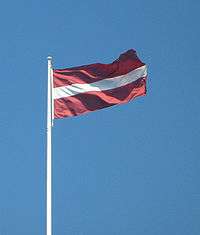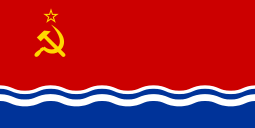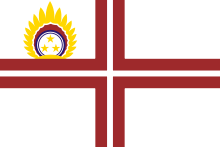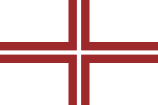Flag of Latvia
 | |
| Use | Civil and state flag, civil ensign |
|---|---|
| Proportion | 1:2 |
| Adopted |
20 January 1923 Restored on 27 February 1990 |
| Design | A carmine field bisected by a narrow white stripe (one-fifth the width of the flag) |
|
Variant flag of Latvia | |
| Use | Naval ensign |
| Proportion | 2:3 |
| Adopted | 1991 |
| Design | White field with cross voided in the colors of the State Flag (the width of the arms of the cross is 1/5 of the flag width). |

The national flag of Latvia was used by independent Latvia from 1918 until the country was occupied by the Soviet Union in 1940. Its use was suppressed during Soviet rule. Shortly before regaining its independence, Latvia re-adopted on 27 February 1990 the same red-white-red flag.
Though officially adopted in 1923, the Latvian flag was in use as early as the 13th century. The red colour is sometimes described as symbolizing the readiness of the Latvians to give the blood from their hearts for freedom and their willingness to defend their liberty. An alternative interpretation, according to one legend, is that a Latvian leader was wounded in battle, and the edges of the white sheet in which he was wrapped were stained by his blood. The white stripe may stand for the sheet that wrapped him. This story is similar to the legend of the origins of the flag of Austria.
History

The red-white-red Latvian flag (German: die banier der Letten ) was first mentioned in the chapters of the Rhymed Chronicle of Livonia (Livländische Reimchronik).[1] This historical evidence places the Latvian flag among the oldest flags in the world. The chronicle tells about a battle that took place around 1279, in which ancient Latvian tribes from Cēsis, a city in the northern part of Latvia, went to war, bearing a red flag with a white stripe.[2]
A legend refers to a mortally wounded chief of a Latvian tribe who was wrapped in a white sheet. The part of the sheet on which he was lying remained white, but the two edges were stained in his blood. During the next battle the bloodstained sheet was used as a flag. According to the legend this time the Latvian warriors were successful and drove the enemy away. Ever since then Latvian tribes have used these colours.
Based on the aforementioned historical record, the present day flag design was adapted by artist Ansis Cīrulis in May 1917. The Latvian national flag, together with the national coat of arms was affirmed in this format by a special parliamentary decree of the Republic of Latvia passed on 15 June 1921.
Occupation
During the period of occupation by the Soviet Union (and briefly by Nazi Germany), the red-white-red Latvian flag was rendered useless from 1940-1941 and 1944-1991. Any production and public display of the nationalist Latvian flag was considered anti-state crime and punishable by law. The first flag was a red flag with the gold hammer and sickle in the top-left corner, with the Latin characters LPSR (Latvijas Padomju Sociālistiskā Republika) above them in gold in a serif font. Starting in 1953, the final version of the flag was adopted. It depicts the Soviet flag with six 1/3 blue wavy bands representing the sea on the bottom.
Restoration
Under the influence of Mikhail Gorbachev's glasnost and perestroika initiatives, the flag of the nationalist Latvia was restored on 27 February 1990 just a year before its restoration of independence.
Colours and proportions
Per Latvian law The Latvian national flag is carmine red with white horizontal stripe. (Latvian: tumši sarkana (karmin))[3] The colour on the flag is sometimes referred to as Latvian red. The red colour of the Latvian flag is a particularly dark shade, which is composed of brown and purple. The flag's colour proportions are 2:1:2 (the upper and lower red bands each being twice as wide as the central white band), and the ratio of the height of the flag to its width is fixed at 1:2.

| White | Red | Red (Fabric) | |
|---|---|---|---|
| Pantone | White | 201C | 19-1629 TPX or 19-1629 TC |
| RGB | Red=255 Green=255 Blue=255 Hex=#FFFFFF |
Red=158 Green=27 Blue=52 Hex=#9E1B34 |
Red=119 Green=53 Blue=61 Hex=#77353D |
| CMYK | Cyan=0% Magenta=0% Yellow=0% Black=0% |
Cyan=25% Magenta=100% Yellow=77% Black=20% |
Cyan=37% Magenta=83% Yellow=63% Black=36% |
Display of the flag

Latvian law states that the flag and national colours can be displayed and used as an ornament if proper respect to the flag is guaranteed. Destruction, disrespectful treatment or incorrect display of the flag is punishable by law.
The flag shall be placed at least 2.5 metres (8 ft 2 in) above the ground and properly secured to the flagstaff. The flagstaff shall be longer than the longest side of the flag, straight, painted white, and preferably made of wood. The finial at the tip of the flagstaff shall be wider than the flagstaff. Where the flag is not displayed continuously, it shall be raised at sunrise and lowered at sunset. If flown for a festival or funeral, it shall be raised before and lowered after the end of the occasion.
If the flag is flown from a flagpole in mourning, it shall be raised to half-mast. If fixed to a flagstaff, a black ribbon whose width is 1⁄20 the width of the flag shall be secured to the flagstaff above the flag; the ribbon shall be of sufficient length to span the width of the flag.
Flag days

- 25 March (in mourning) — In memory of victims of communist genocide
- 1 May — Constitution Day, Labour Day
- 4 May — Restoration of Independence (1990)
- 14 June (in mourning) — In memory of victims of communist genocide
- 17 June (in mourning) — Beginning of the Soviet occupation in Latvia
- 4 July (in mourning) — In memory of victims of the Holocaust (See: The Holocaust in Latvia)
- 11 November — Lāčplēsis Day
- 18 November — Independence Day (1918)
- First Sunday in December (in mourning) — In memory of victims of communist genocide
Official standards

Presidential Standard of Latvia
The Standard of the President is white with the rectangular cross in the colour proportions of the national flag. In the centre of the cross covering the interruption of the colours of the national flag there is the Coat of Arms of Latvia. The height of the Coat of Arms is 1⁄3 of the width of the Standard, the centre of the sun depicted on the shield of the Coat of Arms is in the centre of the Standard. The proportion between the width of the national colours and that of the Standard is 1:5. The proportion between the length and width of the Standard is 3:2.

Standard of the Prime Minister of Latvia
The Standard of the Prime Minister of Latvia is white with the symmetric cross in the colour proportions of the national flag. In top left canton of the flag the Coat of Arms is placed. The height of coat of arms is 5⁄6 of the height of canton, sun of coat of arms is in centre of canton. The proportion between the width of the national colours and that of the Banner is 1:5. The proportion between the length and width of the Banner is 3:2.
Standard of the Speaker of the Saeima
The Standard of the Speaker of the Saeima is white with the symmetric cross in the colour proportions of the national flag. In top right canton of the flag the Coat of Arms is placed. The height of the coat of arms is 5⁄6 of the height of the canton; the sun of coat of arms is in the centre of the canton. The proportion between the width of the national colours and that of the Banner is 1:5. The proportion between the length and width of the Banner is 3:2.
Standard of the Minister of Defence of Latvia

The Flag of the Minister of Defence of Latvia is white with the symmetric cross in the colour proportions of the national flag. In top left canton of the flag the soldier insignia is placed. The height of insignia is 3⁄5 of the height of canton. The proportion between the width of the national colours and that of the Banner is 1:5. The proportion between the length and width of the Banner is 3:2.
See also
References
- ↑ Livlädische Reimchronik: die quâmen hovelîchen dar / mit einer banier rôtgevar,/ daß was mit wîße durch gesniten/ hûte nâch wendischen siten./ Wenden ist ein burc genant,/ von den die banier wart bekant,/ und ist in Letten lant gelegen,/ dâ die vrowen rîtens pflegen/ nâch den siten, als die man./ vor wâr ich ûch daß sagen kan,/ die banier der Letten ist. (09223-09233)
- ↑ Volker Preuß. "National Flagge des Lettland" (in German). Retrieved 2003-04-27.
- ↑ Latvijas valsts karogs ir karmīnsarkans ar baltu horizontālu svītru. (The Latvian national flag is carmine red with white horizontal stripes.)"Latvijas valsts karoga likums (The Latvian flag law)" (in Latvian). The Saeima (legislature) of Latvia. 17 November 2009. Archived from the original on 27 November 2010.
- "Statute of 1994 regarding the National Flag of Latvia" (in Latvian). Archived from the original on 2 March 2009.
- "Statute of 2009 regarding the National Flag of Latvia" (in Latvian). Archived from the original on 27 November 2010.
- The Rhyme Chronicle of Livonia (Ditleb’s von Alnpeke Livländische Reimchronik) (Latvian) (German) (Russian)
- Law regarding Official standards (Latvian)
External links
| Wikimedia Commons has media related to Flags of Latvia. |
- The Latvian Flag fact sheet at the Latvian Institute Web site
- Flags and pendants of Latvian Naval Forces
- Latvia at Flags of the World

